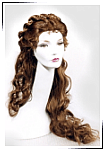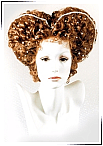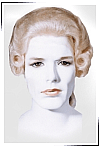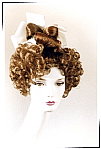| Wearing wigs is not just a trend in the world of fashion. On the contrary, when we look at history we learn that different styles of wigs have always played a significant role in fashion. Depending on the epoch, wigs were either used to demonstrate wealth or to stress the importance of the wearer. The more splendid the era, the more eccentric and pompous hairstyles were created. Wigs also served as a protection against cold and rain. In many wars wigs were also used to impress the enemy. | ||||
 |
|
|||
 |
During the Roman Empire [500 B.C. to 500 A.D.] wigs became especially popular among women. Hairpieces, sometimes colored, were added to increase the volume and therefore the effect of the hairstyle. |
|||
 |
In addition to that, ideas for hairstyling were often taken from Greek tradition and wigs with braids were worn. |
|||
 |
In the Middle Ages [1200 to 1400] wigs lost their importance. It was custom that young women wore their hair long whereas married women covered it with a scarf or a cap. This was with reference to the Apostle Paul [First Letter to the Corinthians] a command and also a sign of a woman’s dependence to her husband. Only he had the right to see her head uncovered. |
|||
 |
It was from the beginning of the Renaissance [1400 to 1600] that the female hairstyle gained again in importance and the hair was no longer completely hidden. It was often put up and arranged with the help of hairpieces, braids and golden taps. |
|||
 |
The French King Louis XIII lost his hair already as a young man. During his reign, the Allonge wig for men was invented and became an important part of every garment. At this time, wigs were mainly made of human or animal hair. Under Louis XIV, the French Royal House employed 48 wig makers at court. |
|||
 |
An enrichment to the world of hair fashion after 1670 was the famous hairstyle à la Fontange, named after a mistress of King Louis XIV countless variations based on the original were created with the help of hairpieces and false locks. |
|||
![Female Hairstyle - Rococo - 1720 to 1789]](other/Rokoko.gif) |
The eighteenth century, better known as Rococo, was the flowering period of wigs. Wigs gained enormously in importance and were adopted as a status symbol by both men and women. During this epoch, wigs were mainly made of Yak hair. The original hair color was natural white and with the help of rice powder it was colored white, blue or pink. |
|||
 |
Especially from 1750 to 1780 hairstylists had a hard job to do arranging some of the female wigs up to a height of 90 cm/35". |
|||
![Female Hairstyle - Rococo - 1750 to 1780 [Backview]](other/Hochrokoko2.gif) |
[Female hairstyle - Rococo - same as above but backview] |
|||
 |
Men used to wear so-called bag or braid wigs. This were wigs with two hairrolls at both sides . With the outbreak of the French Revolution [1789 to 1795] fashion and therefore wigs lost their importance. |
|||
 |
Hairpieces were once again worn around 1820 [Biedermeier] and enjoyed great popularity. The ownhair was tightly arranged around the head and artistic hairstyles were created with side locks and flower like hair loops. |
|||
At the beginning of the twentieth century more and more freely arranged hairpieces were used. With the introduction of short hair cuts around 1920 this trend literaly disappeared over night. In the Sixties hairpieces gained again in importance and the wearing of wigs became almost a must. Wigs were not only sold in specialized shops but in every department store. This strong demand led especially in Asia [South Korea] to an industrialization of the wig production. In this boom days of the wig, intensive research was done in the field of synthetic hair production. Research departments were successful and in a relatively short time good quality synthetic hair was available on the market. Since then, the wearing of wigs and hair pieces has lost it’s importance. Just in the same way as in today’s fashion the motto is simple and comfortable. In everyday life, wigs are hardly ever used except for fashion shows, parties or after a chemotherapy. Through the centuries the production of wigs has not changed in it’s principles. The only difference today is the employment of modern technology and material. However, the production of wigs for theatres and the film industry still takes place in exactly the same way as in former times: through artistic handicraft.
|
||||
Atelier Bassi